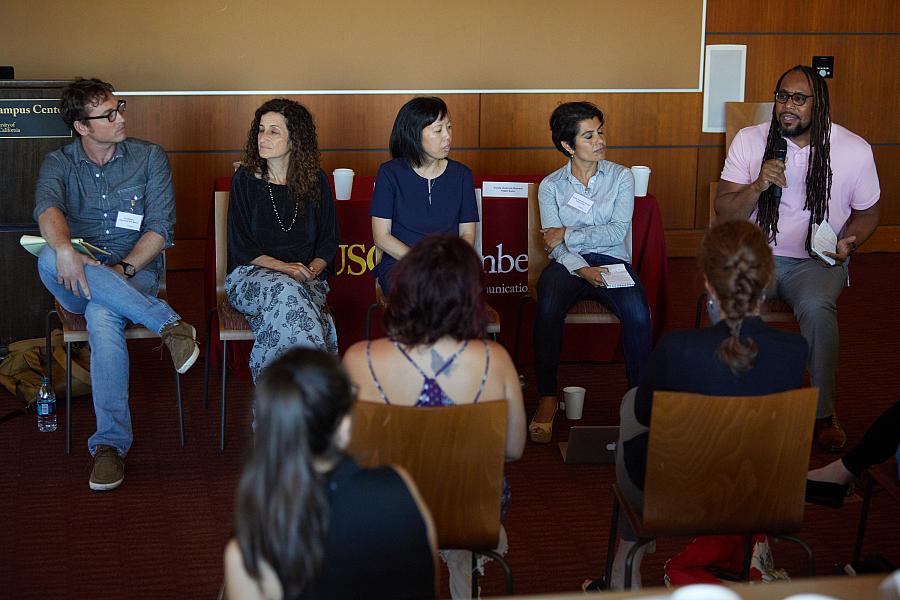Four reporters share strategies for reporting on communities in crisis

From left, Ed Williams, Michelle Levander, Anh Do, Farida Jhabvala Romero and James Causey discuss ideas to keep in mind while reporting on communities in crisis. (Photo by Jeff Skeirik/CHJ)
Journalists must serve as protectors, especially when writing about people with pasts that include trauma or those who reveal sensitive information about themselves, said James Causey, a reporter and columnist for the Milwaukee Journal Sentinel and a 2018 National Fellow.
Causey said he was especially mindful of his role when he set out to tell a series of stories about what happened to his third-grade classmates from Samuel Clemens Elementary School in Milwaukee. He wanted to know: How did their lives change as manufacturing jobs left and the neighborhood experienced "white flight"? Did his classmates find jobs? Did they buy their own homes? How were their lives touched by incarceration?
“This project was so deep and so amazing in so many ways, but I think one thing you have to be prepared with when you delve into projects is you'll be put on an emotional roller coaster,” Causey told a group of reporters as part of the Center for Health Journalism’s 2018 National Fellowship, which focused on vulnerable children and families, and the community conditions that threaten their well-being.
In searching for his classmates, Causey learned that some had died. Some had done well. Others met with misfortune, spent time in jail, or else became involved with gangs. One classmate told Causey he was so poor as a child, he shook roaches out of his coat jacket every morning before school. Causey said he never knew that about his friend.
It took a lot listening, a lot of patience, to get his former classmates to reveal what had happened to them since since 1978, Causey said. But once they started to talk, the stories kept coming. Causey said in those moments, it's important for reporters to listen, and not to judge.
"Don't act surprised when you get someone to talk to you," he said, even when they tell you things you weren’t expecting.
After he wrote each classmate's story, Causey would read the article back to him or her, a usually forbidden practice among journalists, but one he felt was necessary because the details revealed could have hurt people at their jobs or with loved ones.
“When you're dealing with people who are not used to dealing with the media, we have a responsibility to protect them from themselves,” Causey said. “The connections that you make with people last a lifetime.”
Another reporter said patience and persistence is key to her approach. Los Angeles Times reporter Anh Do covers a lot of breaking news stories and said she is often on the scene of crimes where witnesses or family members of victims distrust the media. Do said she speaks in a calm voice and sometimes lets those she is interviewing ask her questions.
At a recent shooting in Silver Lake, where a suspect barricaded himself inside a Trader Joe’s market, Do said she spent five hours interviewing 15 people who witnessed the shooting.
“Many didn't want to give me their names,” she said. “You constantly go on tangents and you allow them a little leeway. I'm very patient. I want their full name. The thing about LA is people are so afraid of being attacked or targeted. I never take no for an answer and I'll go back 10 times if I have to because I must have the full name.”
As a reporter who covers people from immigrant communities, Do said she too is mindful that many have never dealt with the media.
“They are very suspicious,” she said. “I tell them: ‘Just tell me what you want’.”
Farida Jhabvala Romero , an immigration, race, and ethnicity reporter for KQED Radio said that when she's out on breaking news stories, she tries to focus on real people directly affected by what’s happening. Her goal is to connect with them as much as she can to infuse the story with humanity.
For a story about how California wildfires left seasonal agricultural workers in limbo, Jhabvala Romero said she wanted listeners to understand how deep the blaze had cut into people’s livelihoods. In California, Latinos make up 71 percent of agricultural workers.
"I felt like these kinds of stories offer a better, more complicated story of a natural disaster," she said.
But sometimes the voices aren’t easy to find. She said she keeps her eyes on the people she wants to cover by watching and listening.
"Sometimes, even if they don't want to talk to you, there's observation and other ways to report it," Jhabvala Romero said. "I feel like the material doesn't always have to be the voice of the person."
Ed Williams, a staff writer for Searchlight New Mexico, said he set out to report a story about children and poverty. He was sensitive of the fact that New Mexico residents were weary of such stories, because of how many times reporters from national news outlets dropped in their state to write versions of the same negative article.
Williams chose to frame the story differently, using text messages to reach students from Española Valley High School.
For example, he asked questions such as, “What would you ask the principal?”
“We got the principal to answer the students and it proved effective,” he added. He said having the patience and space to ask the community how the story should be framed, made a difference. His deep engagement with the community allowed people to open up and tell their story, Williams added.
“I'm not saying we should tiptoe around our coverage,” Williams said. “I think in communities like this, where there is a history of social injustice, let this kind of community engagement be part of the process.”
**

